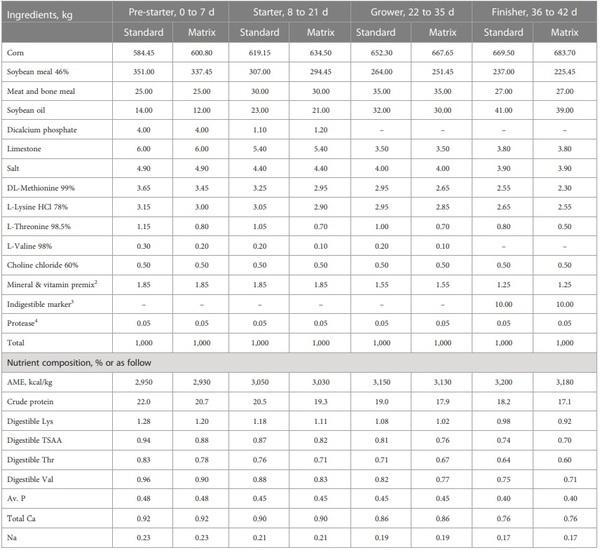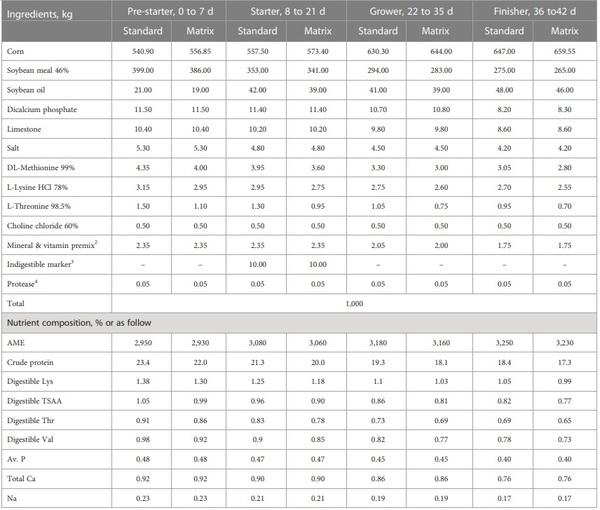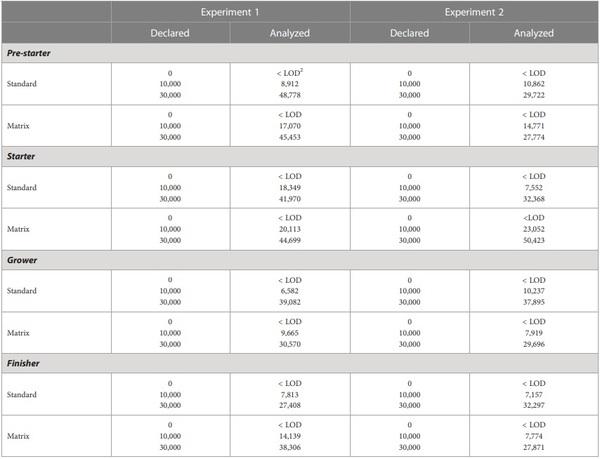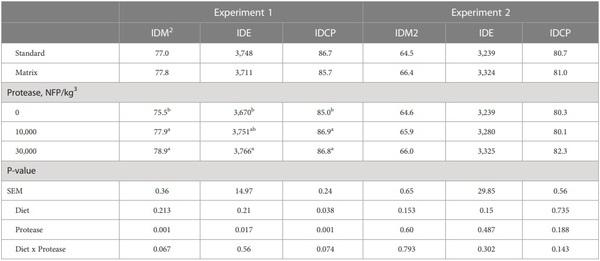Growth performance and nutrient digestibility of broiler chickens as affected by a novel protease
Author details:






Adedokun, S. A., Adeola, O., Parson, C. M., Lilburn, M. S., and Applegate, T. J. (2008).
Standardized ileal amino acid digestibility of plant feedstuffs in broiler chickens and turkey poults using a nitrogen-free or casein diet. Poult. Sci. 87, 2535–2548. doi: 10.3382/ ps.2007-00387
Amerah, A., Romero, L., Awati, A., and Ravindran, V. (2017). Effect of exogenous xylanase, amylase, and protease as single or combined activities on nutrient digestibility and growth performance of broilers fed corn/soy diets. Poult. Sci. 96, 807–816. doi: 10.3382/ps/pew297
Angel, C. R., Saylor, W., Vieira, S. L., and Ward, N. (2011). Metabolism and nutrition:
Effects of a monocomponent protease on performance and protein utilization in 7- to 22- day-old broiler chickens. Poult. Sci. 90, 2281–2286. doi: 10.3382/ps.2011-01482
Baker, D. H. (1994). “Ideal amino acid profile for maximal protein accretion and minimal nitrogen excretion in swine and poultry,” in Proceedings of the Cornell Nutrition
Conference, 56th Meeting, Rochester, New York, USA. 134–139.
Beski, S. S. M., Swick, R. A., and Iji, P. A. (2015). Specialized protein products in broiler chicken nutrition: A review. Anim. Nutr. 1, 47–53. doi: 10.1016/j.aninu.2015.05.005
Bryan, D. D. S. L., Abbott, D. A., Van Kessel, A. G., and Classen, H. L. (2019). In vivo digestion characteristics of protein sources fed to broilers. Poult. Sci. 98, 3313–3325. doi: 10.3382/ps/pez067
Choct, M., and Annison, G. (1992). Anti-nutritive effect of wheat pentosans in broiler chickens: roles of viscosity and gut microflora. Br. Poult. Sci. 33, 821–834. doi: 10.1080/
00071669208417524
Cowieson, A. J., Abdollahi, M. R., Zaefarian, F., Pappenberger, G., and Ravindran, V. (2018).
The effect of a mono-component exogenous protease and graded concentrations of ascorbic acid on the performance, nutrient digestibility, and intestinal architecture of broiler chickens.
Anim. Feed Sci. Technol. 235, 128–137. doi: 10.1016/j.anifeedsci.2017.11.018
Cowieson, A., and Adeola, O. (2005). Carbohydrases, protease, and phytase have an additive beneficial effect in nutritionally marginal diets for broiler chicks. Poult. Sci. 84,
18601867. doi: 10.1093/ps/84.12.1860
Cowieson, A. J., Lu, H., Ajuwon, K. M., Knap, I., and Adeola, O. (2017). Interactive effects of dietary protein source and exogenous protease on growth performance, immune competence and jejunal health of broiler chickens. Anim. Prod. Sci. 57, 252–261. doi: 10.1071/AN15523
Cowieson, A., Toghyani, M., Kheravii, S., Wu, S., Romero, L., and Choct, M. (2019). A mono- component microbial protease improves performance, net energy, and digestibility of amino acids and starch, and upregulates jejunal expression of genes responsible for peptide transport in broilers fed corn/wheat-based diets supplemented with xylanase and phytase. Poult. Sci. 98, 1321–1332. doi: 10.3382/ps/pey456
Cruz, R. F. A., Vieira, S. L., Kindlein, L., Kipper, M., Cemin, H. S., and Rauber, S. M. (2017). Occurrence of white striping and wooden breast in broilers fed grower and finisher diets with increasing lysine levels. Poult. Sci. 96, 501–510. doi: 10.3382/ps/pew310
Cupi, D., Thorsen, M., Elvig-Jørgensen, S. G., Wulf-Anderson, L., Berti-Sorbara, J. O., and Cowieson, A. (2022). Efficacy and safety profile of a subtilisin protease produced by fermentation in Bacillus licheniformis to be used as a feed additive. Heliyon 8, 1–12. doi: 10.1016/j.heliyon.2022.e10030
Dozier, W. A., Kidd, M. T., and Corzo, A. (2008). Dietary amino acid responses of broiler chickens. J. Appl. Poult. Res. 17, 157–167. doi: 10.3382/japr.2007-00071
Erdaw, M. M., Bhuiyan, M. M., and Iji, P. A. (2016). Enhancing the nutritional value of soybeans for poultry through supplementation with new-generation feed enzymes.
World’s Poult. Sci. J. 72, 307–322. doi: 10.1017/S0043933916000271
FAO (2021). World food and agriculture - statistical yearbook (Rome, Italy: FAO).
Freitas, D. M., Vieira, S. L., Angel, C. R., Favero, A., and Maiorka, A. (2011).
Performance and nutrient utilization of broilers fed diets supplemented with a novel mono component protease. J. Appl. Poult. Res. 20, 347–352. doi: 10.3382/japr.2010-00295
Ghazi, S., Rooke, J. A., Galbraith, H., and Bedford, M. R. (2002). The potential for the improvement of the nutritive value of soya-bean meal by different proteases in broiler chicks and broiler cockerels. Br. Poult. Sci. 43, 70–77. doi: 10.1080/00071660120109935
Gilbert, E. R., Wong, E. A., and Webb Jr, K. E. (2014). Board-invited review: Peptide absorption and utilization: Implications for animal nutrition and health. J. Anim. Sci. 86,
2135–2155. doi: 10.2527/jas.2007-0826
Jabbar, A., Tahir, M., Alhidary, I. A., Abdelrahman, M. A., Albadani, H., Khan, R. U., et al. (2021). Impact of microbial protease enzyme and dietary crude protein levels on growth and nutrients digestibility in broilers over 15– 28 days. Animals 11, 2499. doi: 10.3390/ani11092499
Kaczmarek, S. A., Rogiewicz, A., Mogielnicka, M., Rutkowski, A., Jones, R. O., and
Slominski, B. A. (2014). The effect of protease, amylase, and non-starch polysaccharidedegrading enzyme supplementation on nutrient utilization and growth performance of broiler chickens fed corn-soybean meal-based diets. Poult. Sci. 93, 1745–
1753. doi: 10.3382/ps.2013-03739
Kjeldahl, J. (1883). A new method for the determination of nitrogen in organic matter.
Z. für Analytische Chemie 22, 366–382. doi: 10.1007/BF01338151
Kong, C., and Adeola, O. (2014). Evaluation of amino acid and energy utilization in feedstuff for swine and poultry diets. Asian Australas J. Anim. Sci. 27, 917–925. doi: 10.5713/ajas.2014.r.02
Lee, S. A., Bedford, M. R., and Walk, C. L. (2018). Meta-analysis: explicit value of monocomponent proteases in monogastric diets. Poult. Sci. 97, 2078–2085. doi: 10.3382/ ps/pey042
Leinonen, I., and Williams, A. G. (2015). Effects of dietary protease on nitrogen emissions from broiler production: A holistic comparison using lyfe cycle assessment.
J. Sci. Food Agric. 95, 3041–3046. doi: 10.1002/jsfa.7202
Lemme, A. (2003). The “Ideal protein concept” in broiler nutrition 2. experimental data on varying dietary ideal protein levels. Amino News 4. 2, 7–14.
Lemme, A., Wijtten, P. J. A., Van Wichen, J., Petri, A., and Langhout, D. J. (2006).
Responses of male growing broilers to increasing levels of balanced protein offered as coarse mash or pellets of varying quality. Poult. Sci. 85, 721–730. doi: 10.1093/ps/
85.4.721
Levene, H. (1960). “Robust tests for the equality of variance,” in Contributions to probability and statistics: Essays in honor of Harold hotelling. Ed. Stanford, (Palo Alto, CA:
University Press), 278–292.
Liu, S. Y., Selle, P. H., Court, S. G., and Cowieson, A. J. (2013). Protease supplementation of sorghum-based broiler diets enhances amino acid digestibility coefficients in four small intestinal sites and accelerates their rates of digestion. Anim.
Feed Sci. Technol. 183, 175–183. doi: 10.1016/j.anifeedsci.2013.05.006
McCafferty, K. W., Morgan, N. K., Cowieson, A. J., Choct, M., and Moss, A. F. (2022).
Varying apparent metabolizable energy concentrations and protease supplementation affected broiler performance and jejunal and ileal nutrient digestibility from 1 to 35 d of age. Poult. Sci. 101, 101911. doi: 10.1016/j.psj.2022.101911
Moss, A. F., Chrystal, P. V., Truong, H. H., Liu, S. Y., and Selle, P. H. (2017).
Effects of phytase inclusions in diets containing ground wheat or 12.5% whole wheat (pre- and postpellet) and phytase and protease additions, individually and in combination, to diets containing 12.5% pre-pellet whole wheat on the performance of broiler chickens. Anim. Feed Sci. Technol. 234, 139–150. doi: 10.1016/j.anifeedsci.2017.
09.007
OECD/FAO (2021). OECD-FAO agricultural outlook 2021-2030 (Paris: OECD
Publishing). doi: 10.1787/19428846-en
OECD/FAO (2022). OECD-FAO agricultural outlook 2022-2031 (Paris: OECD
Publishing). doi: 10.1787/f1b0b29c-en
Parsons, C. M., Castanon, F., and Han, F. (1997). Protein and amino acid quality of meat and bone meal. Poult. Sci. 76, 361–368. doi: 10.1093/ps/76.2.361
Peek, H. W., van der Klis, J. D., Vermeulen, B., and Landman, W. J. M. (2009). Dietary protease can alleviate negative effects of a coccidiosis infection on production performance in broiler chickens. Anim. Feed Sci. Technol. 150, 151–159. doi: 10.1016/ j.anifeedsci.2008.08.006
Ravindran, V. (2013). Feed enzymes: the science, practice, and metabolic realities.
J. Appl. Res. 22, 628–636. doi: 10.3382/japr.2013-00739
Rawlings, N. D., Waller, M., Barrett, A., and Bateman, A. (2014). MEROPS: the database of proteolytic enzymes, their substrates and inhibitors. Nucleic Acids Res. 42,
D503–D509. doi: 10.1093/nar/gkt953
Recoules, E., Sabboh-Jourdan, H., Narcy, A., Lessire, M., Harichaux, G., Labas, V., et al. (2017). Exploring the in vivo digestion of plant proteins in broiler chickens. Poult. Sci. 96,
1735–1747. doi: 10.3382/ps/pew444
SAS (2013). SAS/STAT 9.4 user’s guide (Cary, NC: SAS Institute Inc.).
Shapiro, S. S., and Wilk, M. B. (1965). An analysis of variance test for normality (complete samples). Biometrika 52, 591–611. doi: 10.2307/2333709
Sklan, D., and Hurwitz, S. (1980). Protein digestion and absorption in young chicks and turkeys. J. Nutr. 110, 139–144. doi: 10.1093/jn/110.1.139
Stefanello, C., Vieira, S. L., Rios, H. V., Simões, C. T., and Sorbara, J. O. B. (2016).
Energy and nutrient utilisation of broilers fed soybean meal from two different Brazilian production areas with an exogenous protease. Anim. Feed Sci. Technol. 221, 267–273. doi: 10.1016/j.anifeedsci.2016.06.005
Tukey, J. W. (1991). The philosophy of multiple comparisons. Stat. Sci. 6, 100–116. doi:
10.1214/ss/1177011945
USDA (2022). Agricultural prices (Washington, DC: United States Department of
Agriculture).
Vieira, S. L., Stefanello, C., and Sorbara, J. O. B. (2014). Formulating poultry diets based on their indigestible components. Poult. Sci. 93, 2411–2416. doi: 10.3382/ps.2013-
03860
Vogtmann, H., Frirter, P., and Prabuck, A. L. (1975). A new method of determining metabolizability of energy and digestibility of fatty acids in broiler diets. Br. Poult. Sci. 16,
531–534. doi: 10.1080/00071667508416222
Walk, C. L., Juntunen, K., Paloheimo, M., and Ledoux, D. R. (2019). Evaluation of novel protease enzymes on growth performance and nutrient digestibility of poultry: enzyme dose response. Poult. Sci. 98, 5525–5532. doi: 10.3382/ps/pez299
Xu, X., Wang, H. L., Pan, L., Ma, X. K., Tian, Q. Y., Xu, Y. T., et al. (2017). Effects of coated proteases on the performance, nutrient retention, gut morphology and carcass traits of broilers fed corn or sorghum-based diets supplemented with soybean meal. Anim.
Feed Sci. Technol. 223, 119–127. doi: 10.1016/j.anifeedsci.2016.10.015
Yuan, L., Wang, M., Zhang, X., and Wang, Z. (2017). Effects of protease and non-starch polysaccharide enzyme on performance, digestive function, activity and gene expression of endogenous enzyme of broilers. PloS One 12, 173941. doi: 10.1371/journal.pone.0173941












_1.jpg&w=3840&q=75)